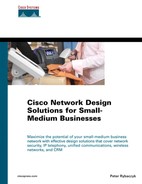Chapter 10. Front and Back Office Integration Solutions
A strategy for the integration of the front and back office applications represents the culmination of the networking solutions discussed in the preceding chapters. The front office applications should allow SMBs to practice better customer relationship management (CRM) after they are integrated effectively with the back office applications that are often viewed as part of the enterprise resource planning (ERP) system. (Remember, CRM is a business strategy and philosophy, not just technology!)
Imagine the routine task of placing an order via a company's website. At some point in the process, a screen pops up and presents additional items that might be of interest to you, based on the item that you ordered. Later, due to your order total exceeding a certain hefty monetary value, another screen offers an automatic promotion: a special discount for an item that is overstocked.
The preceding scenarios represent classic examples of front/back office integration where the typical front/back office applications (order placement and inventory control, respectively) interact in real time to enhance your experience and, in all likelihood, the SMB's bottom line. In the back of your mind, think of all of the underlying networking technologies and solutions, as well as application integration techniques, that have combined to give you that integrated purchasing experience.
The importance that SMBs place on having an integrated applications environment, which can manifest via several techniques, further reinforces the concept of the networking infrastructure as a utility, as discussed in Chapter 3, “Network Infrastructure Requirements for Effective Solutions Implementation.” While the network utility becomes more and more robust and transparent to the end users (not unlike electricity or plumbing), it simultaneously facilitates deployment of varied, complex, competitive, highly integrated, and creative applications.
Applications integration has many guises. It occurs as a process via Enterprise Applications Integration (EAI) tools or some old-fashioned programming (coding) if discrete but noncommunicating modules either from a single or multiple vendors already exist and need to be preserved. The latter integration method also applies for SMBs with in-house developed isolated systems. Applications integration could be a design decision to deploy from scratch an integrated suite from a single vendor that combines elements of what traditionally might be a CRM, an ERP, or newer business applications. A single vendor suite deployment might be a reaction to the previous scenarios of homegrown or too many disjointed applications that no longer meet business needs and simply need to be replaced.
Integration can also mean the addition (seamless or not) of new modules to an existing environment that is already based on open standards, protocols, and platforms. Variants and combinations of the preceding integration techniques apply. What SMBs can count on with regard to the applications environment is that the applications will continue to evolve and become more feature rich, while at the same time preserving their core functions that relate to business fundamentals. The implication is that the process of applications integration is continuous.
Business applications evolve as a function of various economic and political forces, including economic downturns and upswings, globalization, and free trade. The results are competitive pressures for greater productivity and innovation as well as the creation of new workforce models (distributed workforce, telecommuting, flexible work hours, flatter organizational structures). These conditions, in turn, demand responsive applications.
In the course of business operations of a typical SMB that is pummeled by forces beyond its control, changes to applications and their subsequent integration and/or reintegration are not necessarily a singular event with a clearly defined beginning and end. Application integration can become a continuous process with periods of greater activity and subsequent lulls between them.
The surges in the integration activity occur when incompatibilities are discovered due to vendors upgrading their software with new features or when new and disruptive economic and political trends emerge in the marketplace to force changes in business operations. The changes could stem from new laws and regulations that SMBs are required to comply with, new enabling technologies that become widespread, or new markets for SMB's products and services.
Yet, having an integrated applications environment can provide a 360-degree view of all the customer interactions and internal business operations, a perspective that facilitates more informed tactical and strategic, real-time business decision making. This all might sound a bit ideal, but you can decide whether it is or not.
Generically, the trend in computing toward integration is real, and the networking solutions discussed thus far clearly reflect that trend. However, applications integration can be difficult, full of pitfalls, and expensive. Also, the technical obstacles to applications integration can easily pale into insignificance when compared to possible employee or management resistance to the cultural and operational changes that must occur within a business for integration projects to work and to create a fast, positive return on investment (ROI).
